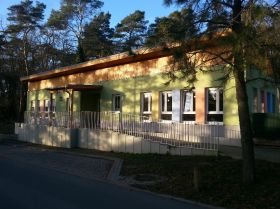Introduction/specifics
The Wilhelmshorst crèche is a small, family facility that is specially designed to meet the needs of small children. We make the transition from family to daycare very sensitive. The focus of adjustment and educational work is the bond between the child and the teacher. It is important to us that the children feel safe and emotionally comfortable in the facility. The building is at ground level and barrier-free to meet the needs of our children. The crèche was opened on March 1st, 2014. It offers space for 34 children aged 2 months to four years. The children are accompanied in everyday life by their reference teachers in two units - yellow and green. This group structure enables us to respond to the very individual and special needs of the youngest. With our educational and situational offers, we want to support the children in their development as best as possible. We focus on the needs, ideas and interests of the children. A good educational partnership between the parents and the educational staff is an important basis for the children to feel comfortable, safe and secure and to be able to develop freely. That is why mutual respect and trust between the educators and the parents is particularly important to us. As part of the cooperation, we work closely with the day-care centers in the municipality of Michendorf, in particular with the Ameisenhügel day-care center in Wilhelmshorst.








